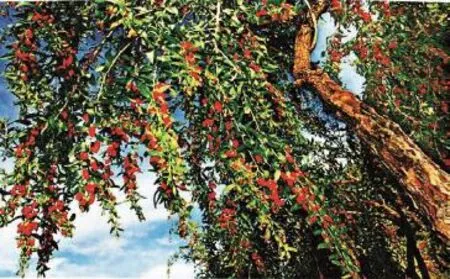Haixi: Pioneer of a Workable Plan for Ecological, Economic and Social Development
By HUANG YUANJUN & HU GE
Haixi: Pioneer of a Workable Plan for Ecological, Economic and Social Development
By HUANG YUANJUN & HU GE

The Alpine Farm of Haixi.
DURING his inspection tour of Qinghai Province in August this year Chinese President Xi Jinping observed that “the most valuable part of Qinghai is its ecology, in which lie the province’s most important responsibility and biggest potential.”President Xi has repeatedly stressed that ecological preservation is in the interest of a society’s long-term and overall development.
Effective Desertification Control
The Qinghai-Tibet Plateau is a place of great natural beauty with its magnificent landscape and untouched environment. Haixi Mongolian and Tibetan Autonomous Prefecture, Qinghai Province,is north of the plateau. Most of Haixi is in the Qaidam Basin, with the Altun and Qilian mountains to its north and the Kunlun Mountain to its south. The region is within easy reach of Gansu,Xinjiang, and Tibet.
The Qaidam Basin, one of the eight biggest deserts in China, is Qinghai’s largest area of desert, and also the hardest to control. Between 2011 and 2015,Haixi prevented and controlled 130,000 hectares of desertification, and reclaimed 147,000 hectares of sandy land,thereby increasing forest coverage and decreasing the amount of desert. These efforts have stopped Haixi from being plagued by a vicious circle, in which ecological management is followed by further damage.
In seeking to develop an economy that prevents and controls desertification and blazes a trail for local farmers and herdsmen to prosper, Haixi has discovered a workable plan - nurturing and developing the goji berry industry.
Flourishing Goji Economy
Guided by the provincial strategy of building an environmentally strong Qinghai, Haixi’s goji berry cultivation has developed in leaps and bounds. The prefecture’s total plantation area has grown from a few sporadic patches to over 27,000 hectares since 2008. Haixi is now China’s second largest goji berry growing region, second only to Ningxia Hui Autonomous Region.
Owing to long hours of sunshine, the large difference between day and night temperatures, and soil rich in potassium and nitrogen, the quality of goji berries here is markedly better than in other regions. Haixi’s dried Chinese goji berries have been certified as organic produce by China’s Quality Certification Center,and certification institutions in the EU,the U.S. and Japan. They are exported to Europe, the U.S. and other Asian countries. Exports of Haixi’s organic goji berries make up 90 percent of the national total.
The Qaidam Basin is one of the native sources of Chinese goji berry, and more than 10 wild varieties grow here. Goji berry trees aged more than 300 years can still be spotted in the region. Among them, the wild black goji berry is a rarespecies with a medicinal value far higher than that of other varieties. Despite this,no proper industry was formed, as only several small plantations existed.
Since 2008, when Haixi’s government named goji berry-planting as the priority industry for local development,the goji berry planting area has been expanded to 29,000 hectares. The annual export volume now stands at 800-900 tons, supported by favorable policies,the promotion of scientific planting, and the introduction of industry standards.
In 2015, the Haixi goji berry brand was assessed as having a net worth of RMB 8 billion. Goji berries account for nearly 50 percent of the output value of Haixi’s agricultural sector, and contribute to nearly 30 percent of the per capita disposable income of local farmers and herdsmen. Meanwhile, great efforts have been made to develop the goji berry processing industry.
In addition to dried and fresh goji berries, the region has developed more than 50 types of goji berry-related products,including condensed juice,beverages, liquor, powder and oil. A complete industrial chain has hence taken shape. This has effectively boosted the added value of the industry, increasing its comprehensive output to more than RMB 7 billion.
Nomuhong Farm set a Guinness World Record with its 5,533-hectare uninterrupted expanse of goji berry trees and its annual output exceeding RMB 800 million. Keluke Town’s 1,333-hectare organic goji berry export base is situated on a former desert. Last year, one farmer earned RMB 920,000 in sales of goji berries to Qinghai Kangpu Biotech Co., Ltd. In Longyang Village, Golmud City, all farmers live in villas and drive cars, thanks to goji berry cultivation. Goji berries, like little rubies,bring wealth to local farmers.
Farmers and herdsmen have directly benefited from improvements in the environment brought about by the wind reduction and sand fixation functions of goji berry planting.

The goji berry cultivation base.
Remarkable Ecological Effect
While creating huge economic benefits, goji berry planting is also proving to be of significant benefit to the environment, especially with regard to water conservation. The goji berry is a dwarf tree with good drought-resistance and high saline-alkaline tolerance. Planting goji berry trees, saxaul, and nitraria tangutorum in vast areas can consolidate oases and inhibit desertification,thus greatly contributing to conservation of water and soil and improving local people’s living and working conditions.
The goji berry needs less water than field crops, but produces higher economic returns. In addition, water-saving irrigation methods can be easily applied to goji berry planting. By adopting trickle irrigation, the water needed for growing goji berries is 3,450 cubic meters per hectare, which means a reduction of 10,500 cubic meters per hectare. The 303 million cubic meters of water saved over 29,000 hectares of goji berry plantations is particularly significant in the water-deficient Qaidam Basin.
Farmers and herdsmen have directly benefited from improvements in the environment brought about by the wind reduction and sand fixation functions of goji berry planting. Farmers from Xiaoxiatan Village in Xiangride Town were relocated here from Haidong Prefecture in 2004. With barren wasteland and deserts hemming the village in from three directions, strong winds sweep through daily in winter and spring. New shoots are often thus buried in sand. Their slender income made desperate farmers consider moving again. However, in 2011, guided by the local government,Xiaoxiatan Village began to develop goji berry planting. Now, dramatic changes have occured in the village. Since turning desert into arable land, villagers’annual per capita income now exceeds RMB 10,000. Xiaoxiatan is only one of many villages in Haixi Prefecture that is prospering from desertification control and the introduction of deserticulture.
Impressive Social Effect
The goji berry industry in Haixi has developed into a comprehensive industrial chain integrating primary, secondary and tertiary industries. First, Chinese goji berry planting has boosted undergrowth industries involving chickens, sheep, honey and animal fodder, thus shaping Haixi’s environmentallyfriendly agricultural cycle.
Second, goji berry planting has attracted a spate of investment. This has spurred the emergence of new processed products, so further extending the industrial chain. Now 50-plus products have been developed, laying a solid foundation for Haixi’s biological industries. Meanwhile, processing, logistics, service, and tourism industries have also been boosted, promoting the integration of different industries.
Third, labor markets in places like Haixi, Haidong, and Haibei have also been invigorated, consequently solving the employment problem of surplus rural laborers and also increasing farmers’income. In 2015, local earnings from picking goji berries reached RMB 517 million in Haixi.
While bringing ecological, economic and social benefits, the Chinese goji berry industry in Haixi has become a workable development plan for the future.

